#katara defense squad
Explore tagged Tumblr posts
Text


my favourite girl as #THAT picture of zendaya :)
#katara#atla#avatar the last airbender#the last airbender#katara atla#katara fanart#katara defense squad#southern water tribe#water tribe#water bending#digital art#my post#digital illustration#digital sketch#one hour piece#digital artist#digital drawing#zendaya
552 notes
·
View notes
Text
wtf do people without fandoms do with their life? like actually what do you do when you don’t have something to dangerously obsess over. the last time i wasn’t a part of a fandom was in fourth grade.
#what do you do#fandom#fanart#fanfic#fantasy#pjo series#pjo#pjo tv show#percy series#percy jackon and the olympians#the lunar chronicles#the rampion crew#across the spiderverse#the hunger games#aaron warner#shatter me#hazbin hotel#avatar the last airbender#percy and annabeth#annabeth chase#books#peeta mellark#katara defense squad#katniss everdeen#prince kai#katara#kenji kishimoto#harry potter#mauraders#divergent
2K notes
·
View notes
Text

Lady of the two lands
#atla#zutara#avatar the last airbender#katara#fanart#zuko x katara#my art#digital art#art#the only character i love blindly is katara#katara defense squad
470 notes
·
View notes
Text
the reason why i'll never take the argument that "fire lady katara disempowers katara" seriously is because in canon she is reduced to being aang's wife and the mother of his children, which actively disempowers her and a lot of the fics i've read with the fire lady katara headcanon have her being involved in politics which demonstrates that for the most part, zutara shippers care more about empowering katara than -GUNSHOTS.
#zutara#fire lady katara#katara#pro katara#katara defense squad#katara deserved better#anti kataang#anti bryke
628 notes
·
View notes
Text
Breaking News: girl who spent years defending Katara sees the Seven Havens announcement and has a hysterical breakdown as she realizes she's going back in the arena
More at 6
#korra deserved better#Like I'm already seeing her haters come crawling out of the woodwork#and I'm so tired#Give me a break PLEASE#I acc can't take this anymore 😭#avatar#atla#a:tla#avatar the last airbender#tlok#the legend of korra#avatar the legend of korra#korra#avatar korra#Katara#katara defense squad#korra defense squad#avatar seven havens#seven havens#fandom discourse#atla fandom discourse#tlok fandom discourse
219 notes
·
View notes
Text
I can’t get over the fact that Bryke decided Katara should believe she deserves no thanks in The Promise. I mean, they literally made her feel guilty for being uncomfortable spending the night with her bfs groupies fangirls.
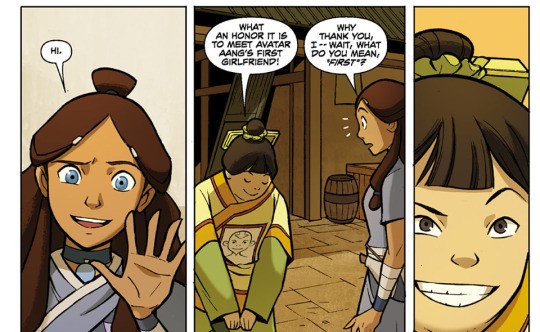


I’ve seen people claim that Aang was oblivious to this. Don’t they get what this is about? His obliviousness doesn’t even matter. Katara's feelings are valid no matter what, and talking about it would have been the only healthy thing to do.
And don’t get me started on those who insist that this shows how both of them had grown since Book 1... This is no growth to me. It seems like Katara, who has always been vocal about her feelings, learned in this one year of her relationship to repress them instead. Either to avoid conflict altogether or because she's been told to 'control herself'. And unfortunately, this is the reality for so many women in RL.
If this is Bryke’s idea of a healthy relationship, I’m actually so glad that Zutara isn’t canon. They could’ve easily made up for the forced K@taang endgame in ATLA by showing a relationship where both sides are validated equally, but instead we got this bs.
If this wasn’t already a bad enough example for girls and young women of what a healthy relationship is supposed to look like, Bryke took it even further: They made the very girls who openly flirted with Aang in front of his girlfriend the official Air Acolytes. In other words, unless Katara and Aang are off on their next adventure, they are surrounded by them almost 24/7.

Yeah, that’s right. Just keep smiling, Master Katara Avatar’s girl.
I mean, what does her life look like surrounded by those Aang-worshiping girls and her boyfriend, who remains oblivious? Constantly smiling, acting as though she doesn't hear the obvious advances happening right in front of her? Ignoring the catty comments directed at her by some of them? And, in general, adjusting to her boyfriend's—later, husband's—life while forgetting her own ambitions? Now, we could argue that she wouldn't stay with Aang if she eventually realizes that she has put up with too much and lost herself. But, I think, we all know that lifelong relationships like this exist in RL.
246 notes
·
View notes
Text
Katara and the “Mom Friend” Trope
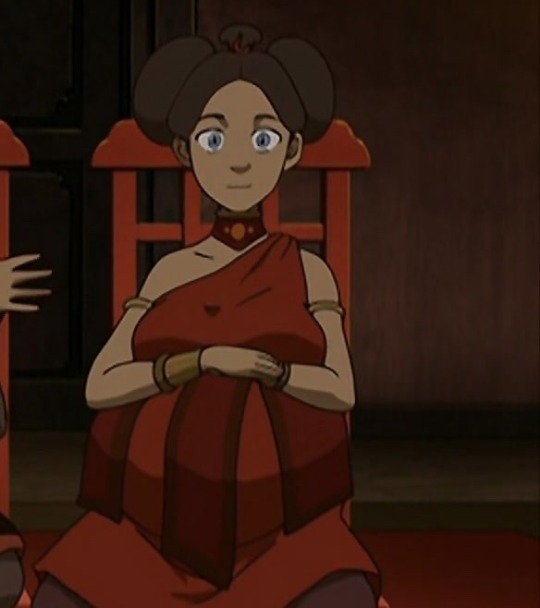
Both in-universe and among fans, Katara has always been identified as the “mom friend.” While often used as a joke, the trope does reveal a deeper and more tragic aspect of Katara’s character: the way the war has forced her to grow up quickly and take on a parental role at a young age.
This is a frequently misunderstood part of Katara’s character, despite it being central to her arc. Since the show first aired, Katara has been the butt of many jokes and has always been one of the most hated characters by fans. From tasteless jokes about how she talks about the loss of her mother too much to accusations of being too emotional and bossy, Katara’s character has always been under attack by fans.
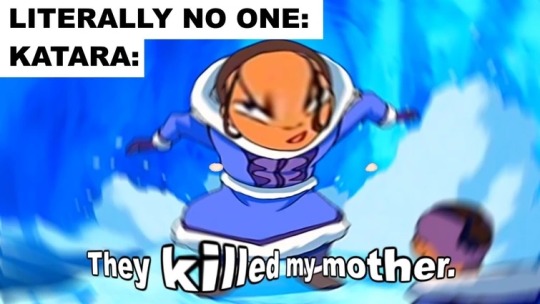
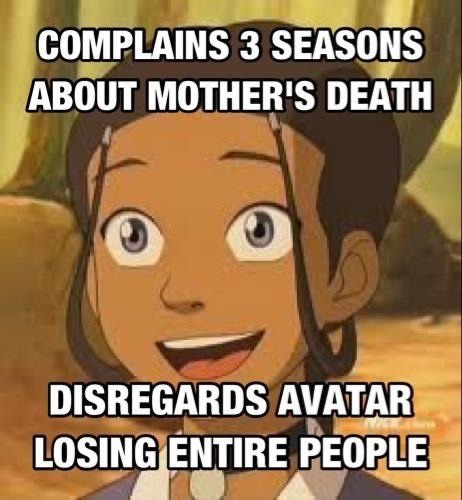
In past years, and still in certain parts of the internet, this behavior was blatant, but lately I’ve noticed a more subtle spin on this. As it becomes slightly less socially acceptable to say blatantly misogynistic things about female characters—particularly here on tumblr—I’ve noticed fans express the same negative sentiments about Katara, but dressed up to appear more progressive. The most common way I see this sentiment expressed is fans downplaying Katara’s role as “team mom��� and trying to make it seem as if Katara is less mature and responsible than she really is.
Of course, these individuals would have you believe that their reasoning for these opinions is that they really care so much about Katara and want to “let her be a kid.” But in reality, when you ignore the way that Katara is forced into a parental role in canon, you also ignore and disregard the context for many of her character traits, leading into the accusations of her being bossy and overly emotional that I mentioned earlier. It erases, and therefore minimizes, a huge source of stress and trauma that weighs on Katara throughout the series.
The idea that Katara fans created the concept of her being a “mom friend” is ridiculous. This is mentioned so much in canon that it’s practically a running joke. Toph accuses Katara of acting like everyone’s mom in The Chase. A similar conflict arises again in The Runaway, when Sokka even admits that he thinks of Katara as a mother figure, despite him being her older brother.
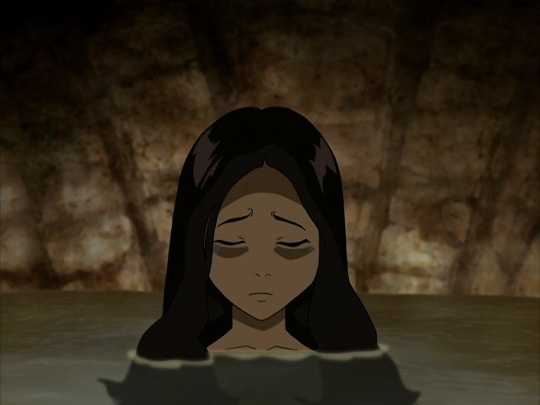
Katara seems pretty hurt by this too, and it’s still never properly addressed again.
In The Headband, Katara actually pretends to be Aang’s mother.
And looking at everything we know about Katara, it’s very clear how she assumed this role. Think about what she says in the exposition of the entire show:
Katara: Ever since mom died, I've been doing all the work around camp while you've been off playing soldier! I even wash all the clothes! Have you ever smelled your dirty socks?
The moment Katara is introduced, the audience is given a critical piece of information about Katara—that she’s lost her mother and essentially assumed her role. While Sokka is more or less playing and occasionally hunting (we hardly ever see him do this in canon by the way), Katara is doing the overlooked, underappreciated labor that keeps everything moving. There is a great post here by @theotterpenguin that details this and the inherent misogyny in devaluing the kind of work Katara does, and how many fans tend to do this.
This trend continues throughout the course of the show. Katara is always the voice of reason who keeps things moving. She reigns in Sokka and Aang, who are constantly getting themselves into trouble.
There are countless examples, but to name a few:
As early as The Warriors of Kyoshi, she’s trying to get Aang to behave and not endanger himself to look cool. And having him mouth off when she gently suggests that he help with a minor chore.
In The Storm, Katara warns Sokka not to take a risky job, which he ignores and nearly gets himself killed.
In The Blue Spirit, Katara is trying the whole time to do something productive via Momo, remaining vigilant despite the sickness wearing her down.
In The Chase, being the one to politely ask Toph to help out, and honestly doing a pretty good job of keeping her cool as long as she did.
The entirety of The Desert episode. While everyone else was drugged up, hopeless, and even outright hostile, Katara kept everything moving and saved everyone’s lives.

Whenever Aang goes into the Avatar State, it’s always Katara tasked with calming him down, despite how dangerous and volatile the Avatar State is when not properly controlled.
Additionally, there are so many small details that add to this picture. Katara is always the one we see getting food, preparing food, doing chores, everything of that nature. Everyone else would be completely lost without her.
And sadly, this is something never properly addressed by the narrative nor acknowledged by fans. There is a great post here by @ecoterrorist-katara explaining the tragedy in this. Katara is constantly burdened with the responsibility of keeping everything moving and doing the invisible labor that is never appreciated but keeps everyone moving, which is the reason why she’s viewed as being in a maternal role. Because that’s what she very clearly is to her friends.
This really wasn’t meant to be a ship related post, but it is kind of the elephant in the room here. I know a lot of the motivation in downplaying Katara’s “mom friend” role stems from shipping discourse, in particular, the hatred of the idea of Katara and Zuko acting as team parents. Some people associate Momtara as a Zutara trope and as a result, relentlessly bash it as they do anything even tangentially related to Zutara. But did you ever consider why it’s a Zutara trope? Because a lot of fans recognize everything I mentioned previously, and enjoy the idea of someone helping to share that responsibility. Sokka, Aang, and Toph clearly didn’t, so that leaves…guess who.
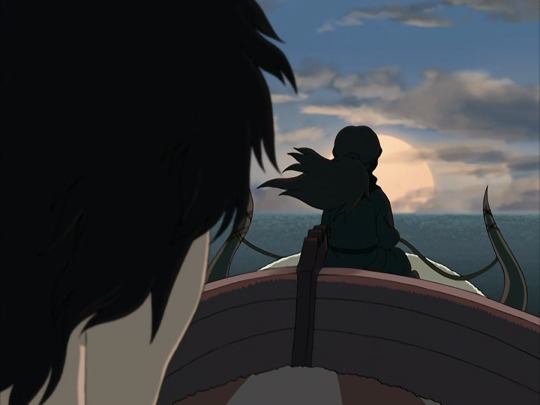
Zuko: You should get some rest. We'll be there in a few hours. You'll need all your strength.
It’s tiring seeing this trend from people who clearly don’t care about Katara or her character. Sure, you might try to act like you’re downplaying Katara’s maternal role and how a huge part of her canon character was the war forcing her to assume that role out of “wanting her to be a kid” but you really aren’t that different from more blatantly misogynistic fans who call her immature and annoying. You don’t recognize or respect the work she’s constantly putting in to protect those around her, and then you have the audacity to get mad at fans of Katara who actually like the idea of someone taking some of that burden off of her shoulders?
Same Katara hate, different font. She is forced into this material role, and refusing to acknowledge this is disrespectful not just to Katara’s character, but all the real life women and girls forced into similar roles who see themselves in Katara.
608 notes
·
View notes
Text
Hey so can we like stop with the "Zutara is for the girls and Kataang is for the boys" thing. It's silly and it's breakdancing just on the edge of gender essentialism.
The assumption that there is something inherent to Zutara that appeals predominantly to women and Kataang that appeals predominantly to men is dishonest because every ship can have appeal to all genders.
The discussion of the "female gaze" in Zutara and the "male gaze" in Kataang is also redundant. I enjoy dissecting the concept of "the gaze", however it is important to note that the "female gaze" doesn't have a set definition or grouping of conventions it adheres to. Lisa French, Dean of RMIT University’s School of Media and Communication says:
“The female gaze is not homogeneous, singular or monolithic, and it will necessarily take many forms... The aesthetic approaches, experiences and films of women directors are as diverse as their individual life situations and the cultures in which they live. The "female' gaze” is not intended here'to denote a singular concept. There' are many gazes."
Now excuse me as I put on my pretentious humanistics student hat.
Kataang's appeal to women and the female gaze
Before I start, I want to note that the female gaze is still a developing concept
There are very few female film directors and writers, and most of them are white. The wants and desires of women of colour, the demographic Katara falls into, are still wildly underepresented. Additionally, the concept of the female gaze had many facets, due to it being more focused on emotional connections rather than physical appearance as the male gaze usually is. Which means that multiple male archetypes fall into the category of "for the female gaze".
The "female gaze" can be best described as a response to the "male gaze", which was first introduced by Laura Mulvey in her paper: "Visual Pleasure and Narrative Cinema" , however the term "male gaze" itself was not used in the paper.
Mulvey brought up the concept of the female character and form as the passive, objectified subject to the active voyeuristic male gaze, which the audience is encouraged to identify, usually through the male character.
To quote her:
"In a world ordered by sexual imbalance', pleasure' in looking has been split between active'/male' and passive/female'. The determining male gaze' projects its fantasy onto the female' figure', which is styled accordingly."
Mulvey also brings up the concept of scopopfillia (the term being introduced by Freud), the concept of deriving sexual gratification from both looking and being looked at. This concept has strong overtones of voyeurism, exhibitionism and narcissism, placing forth the idea that these overtones are what keeps the male viewer invested. That he is able to project onto the male character, therefore being also able to possess the passive female love interest.
However, it's important to note that Mulvey's essay is very much a product of its times, focused on the white, heterosexual and cisgender cinema of her time. She also drew a lot of inspiration from Freud's questionable work, including ye ole penis envy. Mulvey's paper was groundbreaking at the time, but we can't ignore how it reinforces the gender binary and of course doesn't touch on the way POC, particularly women of colour are represented in film.
In her paper, Mulvey fails to consider anyone who isn't a white, cis, heterosexual man or woman. With how underrepresented voices of minorities already are both in media and everyday life, this is something that we need to remember and strive to correct.
Additionally Mulvey often falls into gender essentialism, which I previously mentioned at the beginning of this post. Funny how that keeps coming up
"Visual Pleasure and Narrative Cinema" started a very interesting and important conversation, and I will still be drawing from certain parts of it, however huge swathes of this text have already become near archaic, as our culture and relationship with media evolves at an incredible pace.
And as filmaking evolves, so does our definition of the male and female gaze. So let's see what contemporary filmakers say of it.
In 2016, in her speech during the Toronto International Film Festival , producer of the TV series Transparent, Jill Soloway says:
“Numero uno, I think the Female Gaze is a way of “feeling seeing”. It could be thought of as a subjective camera that attempts to get inside the protagonist, especially when the protagonist is not a Chismale. It uses the frame to share and evoke a feeling of being in feeling, rather than seeing – the characters. I take the camera and I say, hey, audience, I’m not just showing you this thing, I want you to really feel with me.
[Chismale is Soloway's nickname for cis males btw]
So the term "female gaze" is a bit of a misnomer, since it aims to focus on capturing the feelings of characters of all genders. It's becoming more of a new way of telling stories in film, rather than a way to cater to what white, cisgender, heterosexual women might find attractive in a man.
Now, Aang is the decided protagonist of the show, however, Atla having somewhat of an ensemble cast leads to the perspective shifting between different characters.
In the first episode of atla, we very much see Katara's perspective of Aang. She sees him trapped in the iceberg, and we immediately see her altruism and headstrong nature. After she frees Aang, we are very much first subjected to Katara's first impressions of him, as we are introduced to his character. We only see a sliver of Aang's perspective of her, Katara being the first thing he sees upon waking up.
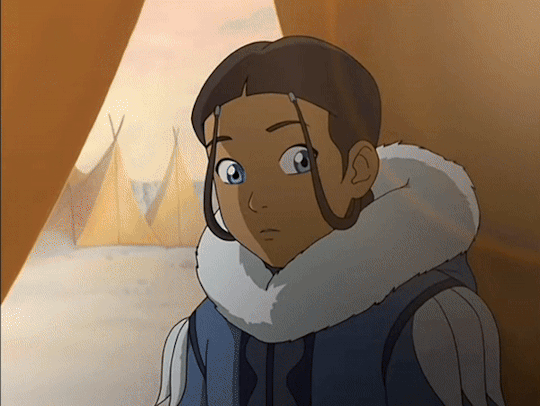
We see that she is intrigued and curious of him, and very excited about his presence. She is endeared and amused by his antics. She is rediscovering her childish side with his help. She is confiding in him about her own trauma surrounding the Fire Nation's genocide of the Southern Waterbenders. She is willing to go against her family and tribe ans leave them behind to go to the Northern Water Tribe with Aang. We also see her determination to save him when he is captured.
As the show moves on and the plot kicks into gear, we do shift more into Aang's perspective. We see his physical attraction to her, and while we don't see Katara's attraction quite as blatantly, there are hints of her interest in his appearance.

This is where we get deeper into the concept of Aang and Katara's mutual interest and attraction for one another. While her perspective is more subtle than most would like, Katara is not purely an object of Aang's desire, no more than he is purely an object of her desire.
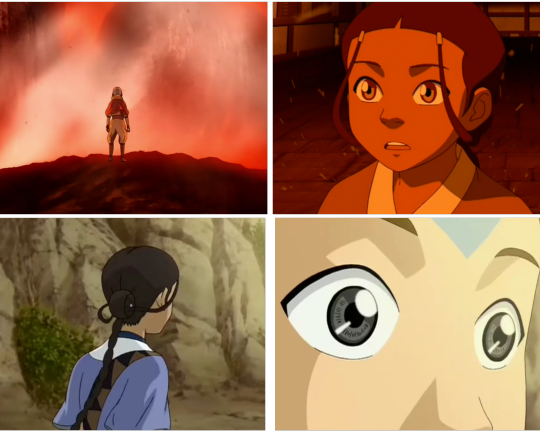
When analysing this aspect of Katara and Aang's relationship, I couldn't help but be reminded of how Célene Sciamma's Portrait of a lady on fire (in my personal opinion, one of the best studies of the female gaze ever created) builds up its romance, and how it places a strong emphasis on the mutuality of the female gaze.
Portrait of a lady on fire's cinematography is very important to the film. We see the world through the perspective of our protagonist, a painter named Marianne. We also see her love interest, Héloïse, the woman whom she is hired to paint a portrait of, through Marianne's lense.
We see Marianne analyse Héloïse's appearance, her beauty. We look purely through Marianne's eyes at Héloïse for a good part of the movie, but then, something unexpected happens. Héloïse looks back. At Marianne, therefore, in some way, also at the audience. While Marianne was studying Héloïse, Héloïse was studying Marianne.
We never shift into Héloïse's perspective, but we see and understand that she is looking back at us. Not only through her words, when she for example comments on Marianne's mannerisms or behaviours, but also hugely through cinematography and acting of the two amazing leads. (Noémie Merlant as Marianne and Adèle Haenel as Héloïse. They truly went above and beyond with their performances.)
This is a huge aspect of the female gaze's implementation in the film. The camera focuses on facial expressions, eyes and body language, seeking to convey the characters' emotions and feelings. There's a focus on intense, longing and reciprocated eye contact (I have dubbed this the Female Gays Gaze.). The characters stand, sit or lay facing each other, and the camera rarely frames one of them as taller than the other, which would cause a sense of power imbalance.
The best way to describe this method of flimaking is wanting the audience to see the characters, rather than to simply look at them. Sciamma wants us to empathise, wants us to feel what they are feeling, rather than view them from a distance. They are to be people, characters, rather than objects.
Avatar, of course, doesn't display the stunning and thoughtful cinematography of Portrait of a Lady on Fire, and Katara and Aang's relationship, while incredibly important, is only a part of the story rather than the focus of it.
However, the 'Kataang moments' we are privy to often follow a similar convention to the ones between Marianne and Héloïse that I mentioned prior.
Theres a lot of shots of Katara and Aang facing each other, close ups on their faces, particularly eyes, as they gaze at one another.
Katara and Aang are often posited as on equal grounds, the camera not framing either of them as much taller and therefore more powerful or important than the other. Aang is actually physically shorter than Katara, which flies in the face in usual conventions of the male fantasy. (I will get to Aang under the male gaze later in this essay)
And even in scenes when Aang is physically shown as above Katara, particularly when he's in the Avatar state, Katara is the one to pull him down, maintaining their relationships as equals.
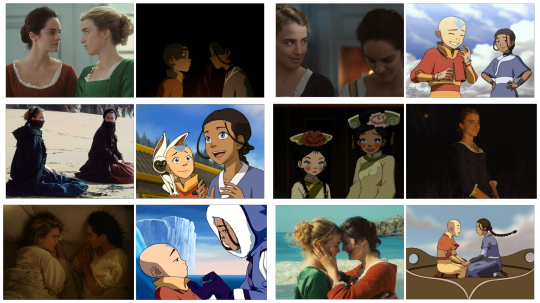
Despite most of the show being portrayed through Aang's eyes, Katara is not a passive object for his gaze, and therefore our gaze, to rest upon. Katara is expressive, and animated. As an audience, we are made aware that Katara has her own perspective. We are invited to take part in it and try to understand it.
Not unlike to Portrait of a Lady on Fire, there is a lot of focus placed on mannerisms and body language, an obvious example being Katara often playing with her hair around Aang, telegraphing a shy or flustered state. We also see her express jealousy over Aang, her face becoming sour, brows furrowed. On one occasion she even blew a raspberry, very clearly showing us, the audience, her displeasure with the idea of Aang getting attention from other girls.
Once again, this proves that Katara is not a passive participant in her own relationship, we are very clealry shown her perspective of Aang. Most of the scenes that hint at her and Aang's focus on their shared emotions, rather than, for example, Katara's beauty.
Even when a scene does highlight her physical appearance, it is not devoid of her own thoughts and emotions. The best example of this being the scene before the party in Ba Sing Se where we see Katara's looking snazzy in her outfit. Aang compliments her and Katara doesn't react passively, we see the unabashed joy light up her face, we can tell what she thinks of Aang's comment.
In fact, the first moment between Katara and Aang sets this tone of mutual gaze almost perfectly. Aang opens his eyes, and looks at Katara. Katara looks back.
There is, once again, huge focus on their eyes in this scene, the movement of Aang's eyelids right before they open draws out attention to that part of his face. When the camera shows us Katara, is zooms in onto her expression as it changes, her blinking also drawing attention to her wide and expressive eyes.

This will not be the first time emphasis is placed on Katara and Aang's mutual gaze during a pivotal moment in the show. Two examples off the top of my head would be the Ends of B2 and B3 respevtively. When Katara brings Aang back to life, paralleling the first time they laid eyes on one another. And at the end of the show, where their gaze has a different meaning behind it.
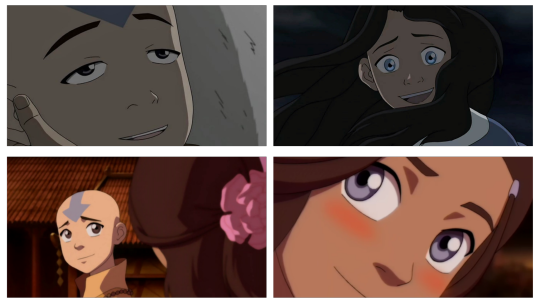
We see Katara's emotions and her intent telegraphed clearly in these instances.
In Book 1, we see her worry for this strange bald boy who fell out of an iceberg, which melts away to relief and a hint of curiosity once she ascertains that he isn't dead.
In B2 we once again see worry, but this time it's more frantic. Her relationship with Aang is much dearer to her heart now, and he is in much worse shape. When we see the relief on her face this time, it manifests in a broad smile, rather than a small grin. We can clearly grasp that her feelings for Aang have evolved.
In B3, we step away from the rule because Aang isn't on the verge of death or unconsciousness for the first time. It is also the first time in a situation like this that Aang isn't seeing Katara from below, but they are on equal footing. I attribute this to symbolising change of pace for their relationship.
The biggest obstacle in the development of Katara and Aang's romance was the war, which endangered both their lives. Due to this, there was a hesitance to start their relationship. In previous scenes that focused this much on Aang and Katara's mutual gaze, Aang was always in a near dead, or at least 'dead adjacent' position. This is is a very harsh reminder that he may very well die in the war, and the reason Katara, who has already endured great loss, is hesitant to allow her love for him to be made... corporeal.
However, now Aang is standing, portraying that the possibily of Katara losing him has been reduced greatly with the coming of peace, the greatest obstacle has been removed, and Katara is the one to initiate this kiss.
Concurrently, Katara's expression here does not portray worry or relief at all, because she has no need to be worried or relieved. No, Katara is blushing, looking directly at Aang with an expression that can be described as a knowing smile. I'd argue that this description is accurate, because Katara knows that she is about to finally kiss the boy she loves.
Ultimately, Katara is the one who initiates the kiss that actually begins her and Aang's romantic relationship.
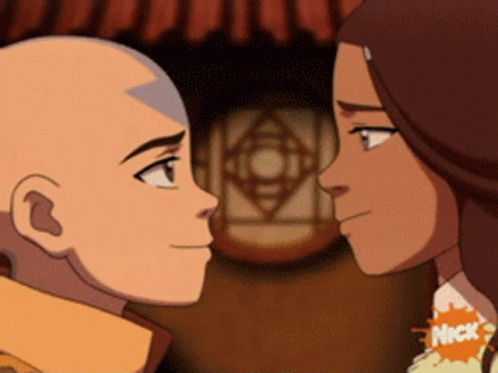
Kataang's appeal to women is reflected in how Katara is almost always the one to initiate physical affection with Aang. With only 3 exceptions, one of which, the Ember Island kiss being immediately shown by the narrative as wrong, and another being a daydream due to Aang's sleep deptivation. The first moment of outwardly romantic affection between Aang and Katara is her kissing his cheek. And their last kiss in the show is also initiated by Katara.
I won't falsely state that Kataang is the perfect representation of the female gaze. Not only because the storyline has its imperfections, as every piece of media has. But also because I simply belive that the concept of the female gaze is too varied and nebulous to be fully expressed. With this essay, I simply wanted to prove that Kataang is most certainly not the embodiment of catering to the male gaze either. In fact it is quite far from that.
The aspects of Kataang that fall more towards embodying the female gaze don't just appeal to women. There's a reason a lot of vocal Kataang shippers you find are queer. The mutual emotional connection between Katara and Aang is something we don't have to identify with, but something we are still able to emphasise with. It's a profound mutual connection that we watch unfold from both perspectives that sort of tracends more physical, gendered aspects of many onscreen romances. You just need to see instead of simply look.
✨️Bonus round✨️
Aang under the gaze
This started off as a simple part of the previous essay, however I decided I wanted to give it it's own focus, due to the whole discourse around Aang being a wish-fullfilling self insert for Bryke or for men in genral. I always found this baffling considering how utterly... unappealing Aang is to the male gaze.
It may surprise some of you that men are also subjected to the male gaze. Now sadly, this has nothing to do with the male gaze of the male gays. No, when male characters, usually the male protagonist, are created to cater to the male gaze, they aren't portrayed as sexually desirable passive objects, but they embody the active/masculine aide of the binary Laura Mulvey spoke of in the quote I shared at the beginning of this essay.
The protagonist under the male gaze is not the object of desire but rather a character men and boys would desire to be.
They're usually the pinnacle of traditional, stereotypical masculinity.
Appearance wise: muscular but too broad, chiseled facial features, smouldering eyes, depending on the genre wearing something classy or some manner of armour.
Personalitywise they may vary from the cool, suave James Bond type, or a more hotblooded forceful "Alpha male" type. However these are minor differences in the grand scheme of things. The basis is that this protagonist embodies some manner of idealised man. He's strong, decisive, domineering, in control, intimidating... you get the gist. Watch nearly any action movie. There's also a strong focus placed on having sway or power over others. Often men for the male gaze are presented as wealthy, having power and status. Studies (that were proved to be flawed in the way the data was gathered, I believe) say that womem value resources in potential male partners, so it's not surprising that the ideal man has something many believe would attract "mates". [Ew I hated saying that].
Alright, now let's see how Aang holds up to these standards.

Well... um...
Aang does have power, he is the Avatar. However, he is often actually ignored, blown off and otherwise dismissed, either due to his age or his personality and ideals being seen as unrealistic and foolish. Additionally, Aang, as a member of a culture lost a century ago, is also often posited as an outsider, singled out as weak, his beliefs touted as the reason his people died out and.
Physically, Aang doesn't look like the male protagonist archetype, either. He isn't your average late teens to brushing up against middle aged. Aang is very much a child and this is reflected in his soft round features, large eyes and short, less built body. This is not a build most men would aspire to. Now, he still has incredible physical prowess, due to his bending. But I'm not sure how many men are desperate to achieve the "pacifist 12 year old" build to attract women.
Hailing from a nation that had quite an egalitarian system, Aang wouldn't have conventional ideas surrounding leadership, even if he does step up into it later. He also has little in the way of possessions, by choice.
As for Aang's personality, well...

I mean I wouldn't exactly call him your average James Bond or superhero. Aang is mainly characterised through his kindness, empathy, cheerful nature and occasional childishness (which slowly is drained as the trauma intesifies. yay.)
Aang is very unwilling to initiate violence, which sets him aside from many other male protagonists of his era, who were champing at the bit to kick some ass. He values nature, art, dance and fun. He's in tune with his emotions. He tries to desecalate situations before he starts a fight.
Some would say many of Aang's qualities could be classified as feminine. While the other main male characters, Zuko and Sokka try to embody their respective concepts of the ideal man (tied to their fathers), Aang seems content with how he presents and acts. He feels no need to perform masculinity as many men do, choosing to be true to his emotions and feelings.
These "feminine" qualities often attract ridicule from other within the show. He is emasculated or infantiliased as a form of mockery multiple times, the most notable examples being the Ember Island play and Ozai tauntingly referring to him as a "little boy". Hell, even certain Aang haters have participated in this, for example saying that he looks like a bald lesbian.
I'd even argue that, in his relationships with other characters, Aang often represents the passive/feminine. Especially towards Zuko, Aang takes on an almost objectified role of a trophy that can be used to purchase Ozai's love. [Zuko's dehumanisation of others needs to be discussed later, but it isn't surprising with how he was raised and a huge part of his arc is steerring away from that way of thinking.]
Aang and Zuko almost embody certain streotypes about relationships, the forceful, more masculine being a literal pursuer, and the gentler, more feminine being pusued.
We often see Aang framed from Zuko's perspective, creating something akin to the mutual gaze of Katara and Aang, hinting at the potential of Zuko and Aang becoming friends, a concept that is then voiced explicitly in The Blue Spirit.
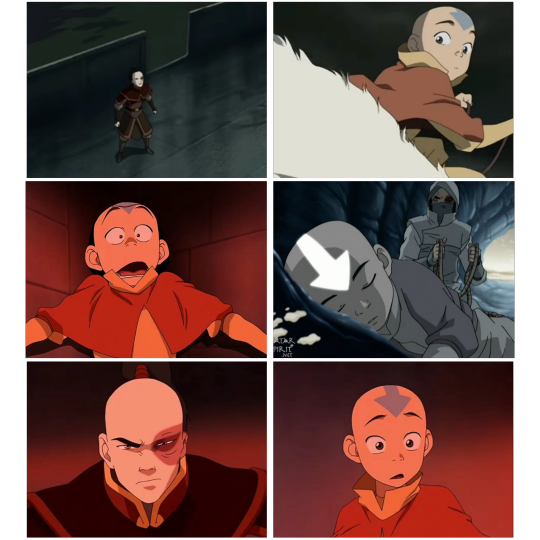
However, unlike Katara, Zuko is unable to empathise with Aang at first, still seeing Aang as more of an object than a person. We have here an interesting imbalance of Aang seeing Zuko but Zuko meerly looking at Aang.
There is a certain aspect of queer metaphor to Zuko's pursuit of Aang, but I fear I've gotten off topic.
Wrapping this long essay up, I want to reiterate that I'm not saying that Zutara isn't popular with women. Most Zutara shippers I've encountered are women. And most Kataang shippers I've encountered are... also women. Because fandom spaces are occupied predominantly by women.
I'm not exactly making a moral judgement on any shippers either, or to point at Kataang and go: "oh, look girls can like this too. Stop shipping Zutara and come ship this instead."
I want to point out that the juxtaposition of Zutara and Kataang as respectively appealing to the feminine and masculine, is a flawed endeavour because neither ship does this fully.
The concept of Kataang being a purely male fantasy is also flawed due to the points I've outlied in this post.
Are there going to be male Kataang shippers who self insert onto Aang and use it for wish fulfilment? Probably. Are there going to be male Zutara shippers who do the same? Also probably.
In the end, our interpretation of media, particularly visual mediums like film are heavily influenced by our own biases, interests, beliefs andmost importantly our... well, our gaze. The creators can try to steer us with meaningful shots and voiced thought, directing actors or animating a scene to be a certain way, but ultimately we all inevitably draw our own conclusions.
A fan of Zutara can argue that Kataang is the epitome of catering to the male gaze, while Zutara is the answer to women everywhere's wishes.
While I can just as easily argue the exact opposite.
It really is just a matter of interpretation. What is really interesting, is what our gaze says about us. What we can see of ourselves when the subject gazes back at us.
I may want to analyse how Zutara caters to the male gaze in some instances, if those of you who manage to slog through this essay enjoy the subject matter.
#ok getting off my soapbox#i forgot how much i love to write these long sprawling essays...#kataang#pro kataang#aang#pro aang#aanglove#aang defense squad#pro katara#katara defense squad#kataang love#zuko#avatar#atla#avatar: the last airbender#the last airbender#avatar the last airbender#aang the last airbender#anti zutara
448 notes
·
View notes
Text
It annoys me that fans & even the ATLA narrative treat Katara’s crush on Jet as if she was simply being silly and shallow. Yes, he was tall and attractive…but he’s also responsible for an entire community of orphans? Maybe after years of parentification, she feels very connected to someone who also had to think about feeding and clothing people and generally keeping them alive? Maybe she admires a boy who seemed to have taken on both her and Sokka’s roles (caretaker and protector), and was really successful at them? Maybe Katara saw a competent boy and liked him just for that!
ATLA narratively chides Katara for liking Jet. He’s coded as this untrustworthy smarmy bad boy character in opposition to sweet friendly Aang. I mean, it’s not subtle: Katara makes a hat for Jet, and after she discovers he’s cool with killing civilians, Aang’s shown wearing the hat. But maybe Katara liked Jet because he had his shit together, while Aang was trying to ride giant fish despite being the saviour of the world! Maybe!
439 notes
·
View notes
Text
Zuko and his protectiveness over Katara backfired on the show
I think we're all quite aware of the fact that Zuko is canonically very protective over Katara
Exhibit A
When he saves Katara from falling rubble in the Western air temple.
Exhibit B
When he protects Katara from flames in that same episode when she is about to blood bend that fire nation soldier.
Exhibit C
The famous Agni Kai where he take lightning for Katara
Now why are these so significant? I think these are big gestures are to show Zuko's efforts to make amends after what he did to Katara. It could be argued these are very extreme ways of making it up to her because these came at the cost of his life. But this also goes to show his character development, as he is willing to protect Katara from danger. For me, one of the reasons why I ship them is because of his protectiveness. It's refreshing to see a character that has always been there to help and to be a support system to others be protected by someone else. I think it can be very fulfilling as a viewer. This effort that was made to write their relationship was so genuine, and it felt so heartfelt as the viewer, that it just made their dynamic one of the strongest in the show. Whether that be romantically or just platonically, their dynamic is probably one of the best in my opinion.
Now, with all that his protectiveness towards Katara immediately evaporate after the last Agni Kai which was pretty shocking, as they didn't get time to be able to talk about what happened. I feel like it removes a piece of genuineness from the show that the characters care for each other. And of course I know a reason why this could have happened is because, well, Kataang and Maiko exist. I think what made their dynamics so strong is because of their protectiveness for one another. Especially, Zuko's protectiveness over Katara. When it was removed in the comics, it felt like a bond had been destroyed because a big part of their dynamic was protecting each other and being there for each other, and having that level of communication. They were protecting each other through their communication and through their support for one another.
How I feel like it backfired on the show is that it created a bit of an emptiness in both of the characters. Especially when they interacted, it felt more distant in the comics, and it felt as if they were strangers. Zuko's writing, which leads to him being protective over her, is so poignant in their relationship that once it is removed it creates a hole in a way it makes his character feel more hollow in his relationship with Katara. It feels like an effort to create a divide and an erasure of their past and how significant his taking lightning for her was. A show that is built of meaningful character relationships took a piece of its own heart out and of its own show and stabbed it in front of all of us when it came to the erasure of Zutara. So they could push the canon ships. They were willing to remove that important element of character relationships for 2 poorly written couples.
I think it creates a level of ingenuity in this show. That is not shocking as many of Katara's other love interests met the same fate of ingenuity, whether that be Jet or Haru. Where she's never able to show her feelings about these people. Which I find quite strange seeing how the show aims to create depth and talk about feelings that actually provoke feelings in you. They don't actually go in-depth with what the leading lady's thoughts are about other people. For all the sake of keeping the focus on Kataang it costs the good writing for Katara to be able to feel complex emotions about the other male interests in her life. And it leads to a rough ending for a strong dynamic like Zuko and Katara that shows their desperation for Kataang at the cost of good writing especially for Katara.
#avatar the last airbender#zutara#zuko x katara#katara#zuko#zuko deserved better#katara defense squad#anti kataang#anti aang#anti maiko#anti mai#anti bryke#bryke critical
224 notes
·
View notes
Text


The first photo is a post on Facebook that I hated and the second photo is my response to what the picture said. Me not judging Katara if she had made the choice to kill Yon Rah makes me a bad person who needs to take a long look in the mirror. I think we need stop this belief that if you kill a remorseless killer who helped commit genocide then you are just as bad as the person who did all that evil.
35 notes
·
View notes
Text

tomdaya × kataang 🕸️❤️🩹🌊🩷
#atla#kataang#avatar#the last airbender#avatar the last airbender#katara#katara atla#aang#avatar aang#atla aang#aang x katara#katara fanart#katara defense squad#kataang fanart#fanart#digital artist#digital sketch#digital drawing#my post#tomdaya#tom holland#zendaya#tomdaya art#digital art
141 notes
·
View notes
Text
The fact that it’s apparently Katara and Azula's job to mother their older siblings, Sokka and Zuko, according to parts of the fandom is so ridiculous and fucked up.
136 notes
·
View notes
Text
i wish katara was real so that she could mop the floor with everyone who doesn't like her 💔
#and why is it always men who talk shit abt her#dont answer that we already know why#katara should be allowed to kill at least one man a day with no repercussions. dont tell aang i said that tho#this post was inspired by a reel i just saw where some guy said that katara is the most selfish member of the group & called her a hypocrite#like?? katara??? selfish?????? KATARA???????? MISS KATARA OF THE SOUTHERN WATERTRIBE?????? are we talking about the same katara???#bro must have watched the show with his eyes closed cause what#i wish men werent allowed to speak about katara 💔#katara#katara defense squad#atla katara
45 notes
·
View notes
Text

This is public enemy 1#??? Get a life fr
#katara#pro katara#atla katara#katara of the southern water tribe#master katara#katara defense#katara defense squad#oh#katara my beloved#im the biggest Katara fan out there i swear#she's my sweetheart she's my sister she's my best friend#i've never been so protective of any fictional character i swear#atla#avatar aang#a:tla#avatar: the last airbender#avatar the last airbender#avatar
52 notes
·
View notes
Text
saw a comment say that katara being a fighter and mother were never a dichotomy and how even as a mother (at least in tlok) we don’t see her do much in terms of even being a mom and i had to think a bit
and yeah shes not present as a mom or grandma and damn they have her not even the bare minimum to do
#red rambles#avatar the last airbender#anti kataang#atla critical#katara deserved better#katara defense squad#there’s nothing wrong with being a mom#but they had my girl doing nothing
98 notes
·
View notes